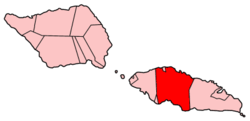Malua

Malua is a small village on the Samoan island of Upolu. The name originates from the Samoan word "Maluapapa" which is translated 'shelter under the rock'. It is located on the northwestern coast of the island in the electoral constituency (faipule district) of Sagaga Le Falefa which forms part of the larger political district Tuamasaga.[1] The village is part of the electoral constituency (Faipule District) Gaga'emauga III which forms part of the larger political district of Gaga'emauga.
The population of Malua is 394 (2006 Census).[2]
Malua is the centre for the Congregational Christian Church in Samoa and also the site of the famous Malua Theological College which was the second theological college to be established in the South Pacific in 1844, the first being Takamoa Theological College in Cook Islands.[3] Founded by the London Missionary Society, Malua quickly became the centre for training pastors and missionaries in the Pacific. Today Malua is where all activities for the Congregational Christian Church in Samoa are centred, especially its General Assembly held annually in May.
A prominent Samoan who attended Malua Theological College was historian Teo Tuvale whose father, a pastor at Faleasi'u village, had been one of the first students to study at the seminary during the 19th century.
References
- ↑ "Samoa Territorial Constituencies Act 1963". Pacific Islands Legal Information Institute. Retrieved 19 December 2009.
- ↑ "Population and Housing Census Report 2006" (PDF). Samoa Bureau of Statistics. July 2008. Retrieved 19 December 2009.
- ↑ Pereeti, Tekere (1989). "TAKAMOA THEOLOGICAL COLLEGE 1839-1989 150th Anniversary Celebrations J. Russell Chandran Wednesday, 2 August, 1989 was a festive day not only for Takamoa Theologi-cal College but for the Cook Islands Christian Church (CICC) and all the people". Pacific Journal of Theology. 2 (93).
